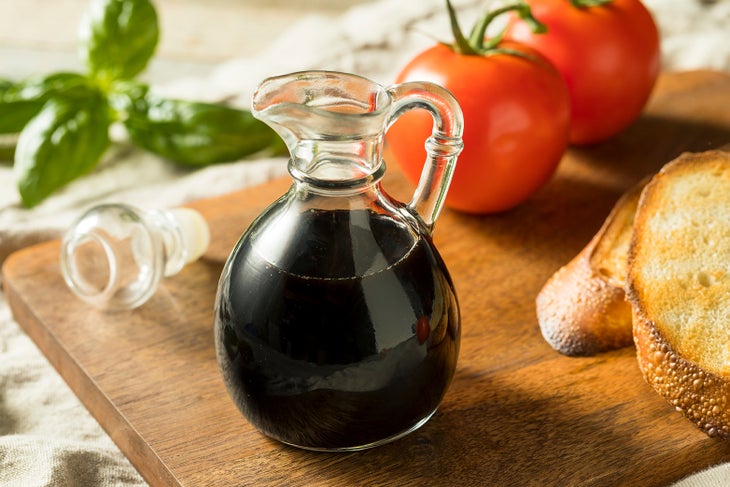Heading out the door? Read this article on the new Outside+ app available now on iOS devices for members! Download the app.
Derived from the French “vinaigre” (meaning aged wine), vinegar is a staple in most pantries worldwide. With dozens of varieties readily available, you can use your favorite type to elevate nearly any meal – by creating marinades, emulsifying vinaigrettes, seasoning dishes to brighten flavors, or even making reductions.

How it’s made
The process of producing vinegar includes inoculation, fermentation and aging. An alcoholic liquid is acted upon by the Acetobacter bacteria to form an acidic solution. It evolves into a self-preserving substance due to its high acidity. Fermentation of wine into vinegar is triggered by a “mother,” or other ambient bacteria, transforming sugars into alcohol into acetic acid; a vinegar “mother” is a harmless cellulose structure produced by acetic acid that occurs naturally in unpasteurized vinegars. The process may take from 20 hours up to several months, depending on a variety of factors.
Types of Vinegars
Rice: With a 4% acidity, rice vinegar is great for pickling, dressings, or seasoning sushi rice. (Check out our Garlic and Kale Soup that uses Brown Rice Vinegar.)
Balsamic: Made from the concentrated juice of white Trebbiano grapes and aged in casks, balsamic works well in glazes, reductions and marinades with its 6-8% acidity. (Try our Sicilian-Style Roasted Vegetables with Balsamic Syrup.)
Apple Cider: With a 5% acidity, this one’s best for seasoning more subtle dishes, as an infusion, or drizzled over grain or bean salads. (Use it to make Carolina-Style Barbecue Sandwiches.)
Wine: With a 6-8% acidity, this vinegar adds a touch of umami, and works well wherever a stronger flavor is desired. (Make Minestrone with Sun Dried Tomatoes and White Beans.)
Coconut: Made from fermented coconut water or sap, coconut vinegar has a 4% acidity, and is perfect for a splash of brightness when making nut-based cream sauces or a stone fruit chutney.
Health Benefits
Unpasteurized and unfiltered vinegar is a natural probiotic and can be used to help the body break down fats. Unfiltered apple cider vinegar is used to treat sore throats and upset stomachs, as well as topically for some skin conditions; it is also a natural liver cleanser. In addition, vinegar can get digestive juices flowing and increase appetite, which makes it a great addition to starter courses like salads and chilled soups. (Check out our article: Apple Cider Vinegar: Healing Foods)
How to Buy
Be sure to carefully examine labels and ingredient lists, and purchase varieties free of additives and artificial coloring. Keep in mind that aged vinegars have stronger flavors. Gradually stock your kitchen with different types of vinegars to determine which you like best for different applications.
Culinary Uses
Reductions: Reduce over medium heat until mixture coats the back of a spoon. Serve over fresh berries, or when plating an entrée or salad course. (Top Red Pepper Soup with a Balsamic Reduction.)
Herb Infusions: Blanch herbs like tarragon, dill or basil, blend with vinegar, and allow to steep for a few days in the fridge.
Marinades: Use to tenderize and flavor vegetables like mushrooms, zucchini and eggplant before grilling, along with fresh garlic, ginger and herbs.
Quick Pickle: Add three parts vinegar to one part water to a small saucepan and bring to a boil, adding a splash of sweetener of your choice, a pinch of salt, and red chili flakes for extra spice. Pour over cut produce and allow to sit for at least 30 minutes, or overnight in the refrigerator. (Try our Hot-and-Sour Celery Pickles.)
Baking: Can be used as a leavener, eliciting a chemical reaction to produce carbon dioxide to give cake batters a lift.
Poaching eggs: Adding a tablespoon to the cooking water with prevent eggs from spreading.
Ceviche: Mix with oil, garlic and herbs, and toss with mushrooms or avocado for a refreshing twist. Serve with tortilla crisps.
Enhance color: Vinegar brightens reds and purples, like cabbage and beets or red pearl onions.
Eager to learn more about how to shop, cook, and eat more healthfully as a vegetarian? Join our eight-week course Foundations of Plant-Based Nutrition with the Natural Gourmet Institute. Sign up now!